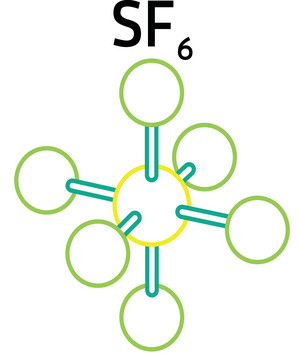KANBrief 3/20

Part 3 of EN 14175 describes a range of type test procedures for fume cupboards. The required test gas mixture contains sulphur hexafluoride (SF6). Although non-toxic, this gas is highly harmful to the climate, with a global warming potential some 30,000 times that of CO2. Since SF6 is already prohibited in many countries, an alternative is needed. Nitrous oxide (N2O) is being discussed as a possible substitute. This gas is however not without its problems for occupational safety and health.
The containment capacity of a fume cupboard is determined in accordance with EN 14175-3 in a special test room in the type test. It describes the capacity of a fume cupboard to retain airborne substances inside the cupboard. The containment capacity is determined by the design of the fume cupboard, the volumetric flow rate of the exhaust air, the size of the front sash opening, and other underlying conditions. Tests are performed as per the standard with sulphur hexafluoride (SF6) serving as the test gas. The standard does not cover evaluation of the test results; this is set out in national regulations. The type test should also provide information on the behaviour of a fume cupboard in everyday use (for example for determining the required minimum volumetric flow rate of exhaust air for a required containment capacity).
Where fume cupboards have not been type-tested, their containment capacity must be tested individually on site before they are put into use for the first time. In addition, annual tests on site are mandatory for all fume cupboards. The methods for on-site tests are described in Part 4 of EN 14175. For performance of the test, reference is also made to Part 3. As in the type test, SF6 is specified here as the test gas.
SF6 is an ideal tracer gas: it has an extremely low background concentration, is largely chemically inert and non-toxic, has high infrared absorption, and is relatively easy to detect even at low concentrations. Since its use is already prohibited in some countries owing to the harm it causes to the climate, alternatives must be found. A test performed with an alternative to SF6 must be safe for the parties involved and also comparable to existing type test methods for fume cupboards.
Nitrous oxide (N2O) is currently being discussed as a possible alternative to SF6 for measurement of the containment capacity. Fume cupboard tests have already shown the measured values and concentration curves of the two gases to be identical. N2O was already in use as a tracer gas for ventilation tests in indoor areas before the advent of SF6. It is only around 300 times more harmful to the climate than CO2.
Owing to the toxicity of nitrous oxide however, its use must be limited to type-testing in a test room in which persons are not present. N2O is generally unsuitable for use in on-site tests, as the possibility cannot be ruled out of fume cupboards having significant leakage and the maximum permissible workplace concentration for persons present being exceeded.
The use of N2O in type-testing would provide time for further alternatives to SF6 to be found. N2O is however probably not a complete substitute for all purposes. A particular challenge for standardization is the selection of alternative test methods that enable type examinations and on-site tests to be conducted safely and assure comparability to the previous methods employing SF6.
An ad hoc group of CEN/TC 332/WG 4, Fume cupboards and associated ventilation, is currently working on a new proposed method for EN 14175-3. Approval of other substitutes for SF6 in addition to N2O, which deliver at least the same accuracy and measurement uncertainty, is currently under discussion. It is not yet clear whether it will be possible in the future for the same methods to be used for both type-testing and certain on-site tests. Alternative test substances and test methods, based for example on particles and aerosols, are also currently being discussed.
Due to the fundamental importance of containment capacity measurements, it appears advantageous for use to be made of the time gained by the amendment of Part 3 of the standard permitting the use of N2O. A research initiative coordinated at European level, for example, could develop a “toolbox” of safe test methods and recommendations for their use. It would be to users’ advantage if in the longer term, the assessment criteria for the containment capacity of all commonly used ventilated safety equipment (fume cupboards, safety cabinets, weighing stations, etc.) could be standardized.
Albrecht K. Blob, Monheim am Rhein
ak-blob@web.de
The author was active for many years in the standardization of laboratory equipment at European and national level.